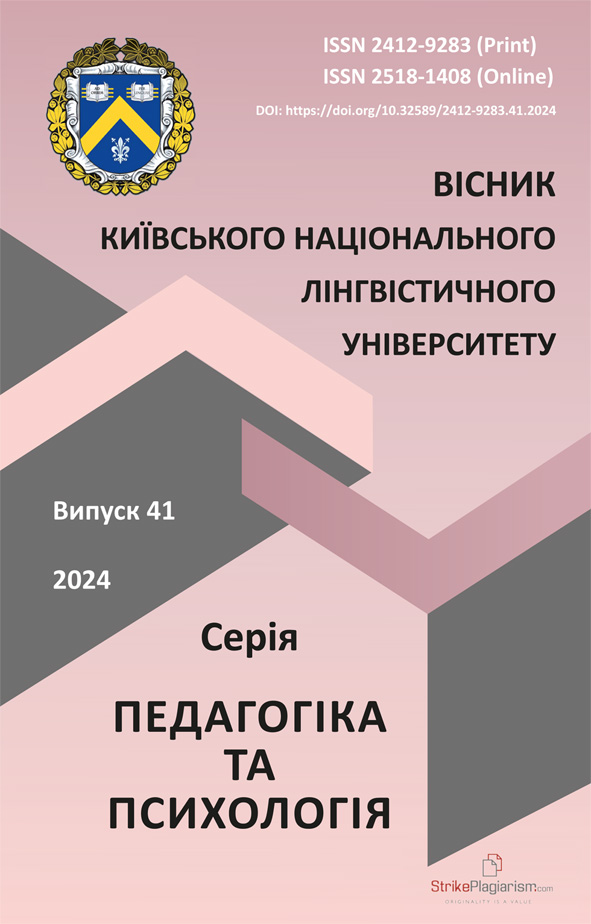Щодо важливості вивчення досвіду Японії в реалізації реформи «Нова українська школа»
DOI:
https://doi.org/10.32589/2412-9283.41.2024.322950Ключові слова:
the “New Ukrainian School” reform, moral education, school system, state schools, school management, value educatioАнотація
Система шкільної освіти в Україні переживає сьогодні серйозне реформування, особливої уваги у зв’язку з цим потребує найважливіший її складник – ціннісне виховання, у реалізації якого може допомогти успішний досвід Японії. Загалом вектор освітньої реформи в Україні близький до освітньої практики сучасної Японії. Підходи до організації навчання, різноманітні освітні ресурси, залучення представників інших культур, носіїв мови, зокрема ALT («помічник вчителя мови») в Японії мають багато спільного з практикою кращих, зокрема приватних шкіл, чого часто не вистачає школам державним, особливо сільським в Україні. Зважаючи на нагальність забезпечення рівності в освіті, це дослідження вивчає контекст, що забезпечує успіх японської школи з метою використання його в практиці шкільної освіти в Україні.
Посилання
Arimoto, M. (2019). Using classroom assessment to improve pedagogy: the Japanese experience. https://www.researchgate.net/publication/334481251
Asian Ed topics, (2013). Integrated Studies in Japan: Problemetizing a ‘Successful’ Reform.
https://asianedtopics.wordpress.com/2013/04/10/52/
Asian-Pacific Economic Cooperation, (2017). APEC Education Strategy.
http://mddb.apec.org/Documents/2017/HRDWG/EDNET/17_hrdwg_ednet_003.pdf
Asian-Pacific Economic Cooperation, (2019). APEC at a Glance.
https://www.apec.org/Publications/2019/02/APEC-at-a-Glance-2019
Benjamin, G. R. (1998). Japanese lessons: a year in a Japanese school through the eyes of an American anthropologist. New York University Press. 272 p.
Cave, P. (2016). Schooling selves. Autonomy, interdependence, and reform in Japanese junior high education. Chicago and London: The University Chicago Press.
CIA, (2020, June 11). The World Factbook.
https://www.cia.gov/library/publications/the-world-factbook/geos/up.html
CRICED, (2019). Education system and practice in Japan.
http://www.criced.tsukuba.ac.jp/keiei/kyozai_ppe_f7.html#18
CULCON. (2003). School life in Japan. http: // www.crosscurrents.hawaii.edu
Deren, K. et al., (2018).The prevalence of underweight, overweight and obesity in children and adolescents from Ukraine. DOI: 10.1038/s41598-018-21773-4
Euroosvita, (2016, August 21). Education financing: how much, to whom and how? [Finansuvannya osvity: skilʹky, komu i yak?].
http://www.euroosvita.net/index.php/?category=1&id=4879
European Union, (2020). European policy cooperation.
https://ec.europa.eu/education/policies/european-policy-cooperation/et2020-framework_en
European Union, (2020). The EU in brief. Goals and values of the EU.
https://europa.eu/european-union/about-eu/eu-in-brief_en
European Union, (2020). What it is and what it does. http://publications.europa.eu/webpub/com/eu-what-it-is/en/
Halstead, J., Taylor, M. (1996). Values in Education and Education in Values.
https://files.eric.ed.gov/fulltext/ED393218.pdf
Harlan, C. (2013, January 26). On Japan’s school lunch menu: A healthy meal, made from scratch.
Hrabovska, A. (2018, December 12). The European Parliament has approved an agreement on the EU free trade area with Japan [Європарламент схвалив угоду про зону вільної торгівлі ЄС із Японією].
Iwasaki, K., Watanabe, T., Tamura, T. (2017). The significance of group supervision to yogo teachers in Japan. Journal of Education and Training Studies, vol. 5 (9). Published by Redfame Publishing. DOI: 10.11114/jets.v5i9.2587
Jabar, M. (2010). How do Japanese schools promote parental involvement? International Journal of Social Sciences And Humanity Studies, vol. 2 (1).
http://www.sobiad.org/ejournals/journal_ijss/arhieves/2010_1/11melvin_jabar.pdf
Japan forum, (2001). Futsu-ka (general education program), senmon gakka (specialized or vocational progams), sogo gakka (integrated programs).
http://www.tjf.or.jp/ deai/contents/teacher/ mini_en/html/ futsuka.html
Japan forum. (2019). Supplementary information about elementary school.
http://www.tjf.or.jp/shogakusei/exp/exp01_e.htm
Japan Society for the Promotion of Science. (2019). Science dialogue problem. https://www.jsps.go.jp/english/e-plaza/e-sdialogue/index.html
JICA. School Health Programs. https://www.jica.go.jp/jica-ri/IFIC_and_JBICI-Studies/english/publications/reports/study/topical/health/pdf/health_11.pdf
Kawano, K. (2016, July 16). Child safety tips from Japanese schools: basic education. https://savvytokyo.com/basic-education-child-safety-tips-japanese-schools/
Keith, D. K. (2011). Cross-Cultural Psychology: Contemporary Themes and Perspectives. Oxford. Blackwell Publishing.
Kimura, D., Tatsuno, M. (2017). Advancing 21st Century Competencies in Japan.
https://asiasociety.org/files/21st-century-competencies-japan.pdf
Lewis, K. (2017, October 2). How Japan raises resilient children: from ‘ganbatte’ vs. ‘good luck’ to teaching hard work and effort. https://savvytokyo.com/japan-raises-resilient-children/
Makhniy, M. (2011). Unusual anthropology [Nezvychayna antropolohiya]. Chernihiv: ChNPU publishing, 2011. 188 p.
Ministry of Education and Science of Ukraine, (2011). Osnovni oriyentyry vykhovannya uchniv 1-11-kh klasiv zahalʹnoosvitnikh navchalʹnykh zakladiv Ukrayiny (prohrama) [Value education guidelines for Ukraine secondary school students of 1–11 grades]. http://old.mon.gov.ua/images/files/pozashkilna/1243.doc
Ministry of Education and Science of Ukraine, (2016). The New Ukrainian school. https://mon.gov.ua/storage/app/media/zagalna%20serednya/Book-ENG.pdf
Ministry of Education, Culture, Sports, Science and Technology of Japan. (2008). The Revisions of the Courses of Study for Elementary and Secondary Schools.
http://www.mext.go.jp/en/policy/education/elsec/title02/detail02/__icsFiles/afieldfile/
/03/28/1303755_001.pdf
Mystudyabroadjapan. (2016, May 8). Japanese School Trips. [Blog post].
http://mystudyabroadjapan.blogspot.com/2016/05/japanese-school-trips.html
Naito, T. (1991). Moral education in Japanese public school.
https://www.researchgate.net/publication/235968778_Moral_education_in_Japanese_public_schools
National Institute for Educational Policy Reserch, (2017). Teacher transfer and appointment system in Japan.
https://www.nier.go.jp/English/educationjapan/pdf/201703TTASJ.pdf
OECD, (2005). The Definition and selection of key competences. Executive Summary. https://www.oecd.org/pisa/35070367.pdf
OECD, (2010). Strong Performers and Successful Reformers in Education: Lessons from PISA for the United States. Paris: OECD publishing.
OECD, (2018). Education policy in Japan, Building bridges towards 2030. Reviews on National policies for education. Paris: OECD publishing.
https://read.oecd-ilibrary.org/education/education-policy-in-japan_9789264302402-en#page4
Ojio, Y. (2015). Development of a mental health literacy program for secondary school students and its effects: In-school mental health literacy education. Center for Excellence in School Education, Graduate School of Education, The University of Tokyo. Working Paper Series in Young Scholar Training Program.
Resolution (2004). Pro Natsionalʹnu prohramu vykhovannya ditey ta uchnivsʹkoyi molodi v Ukrayini [About National value education program for children and young adolescents]. The National Academy of Educational Sciences of Ukraine.
https://zakon.rada.gov.ua/rada/show/v6-98601-04
Rossides, N. (2020). Exploring Japanese culture: not inscrutable after all. Troubador Publishing Ltd. 2020. 184 pp.
Saito, Y. (2011). Distinctive features of the Japanese education system.
https://www.nier.go.jp/English/educationjapan/pdf/201103DFJE.pdf
Singer, J., Gannon, T., Nogucci, F., Mochizuki, Y. (2016). Educating for Sustainability on Japan: Fostering resilent communities after triple disasters. Taylor and Francis, 292 pp.
Schleicher, A. (2018). World Class: How to Build a 21st-Century School System, Strong Performers and Successful Reformers in Education. OECD Publishing, Paris.
https://doi.org/10.1787/9789264300002-en.
Shutko, V. (2014). Problemy fizychnoho vykhovannya shkolyariv cherez pryzmu pohlyadiv uchytelya [Physical education problems of schoolchildren through the prism of teacher’s views]. High and Secondary School Pedagogy /Педагогіка вищої та середної школи, vol. 40. pp. 155–160
Sysoieva, S. (2013). Osvitni reformy: osvitolohichnyy kontekst [Education reforms: educological context]. The theory and practice of social systems management/Теорія і практика управління соціальними системами, vol.2. Kharkiv: KhDPU. pp. 44–55
The Global Competitiveness Report, (2019).
http://www3.weforum.org/docs/WEF_TheGlobalCompetitivenessReport2019.pdf
Tsuneyoshi, R. et al (2012). The World of tokkatsu: the Japanese approach to whole child education.
Zahorodnya, A. (2018). The contents differentiation in high school: historical and analytical aspect. [Dyferentsiatsiya zmistu navchannya u starshiy shkoli: istoryko-analitychnyy aspekt].


